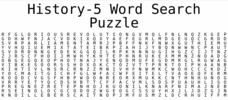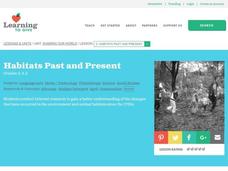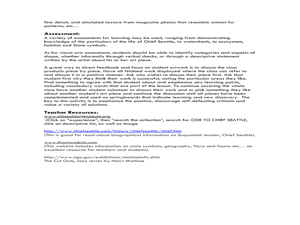Curated OER
Lesson Plans on the Intersection of History and Literature
Finding out about "the story behind the story" can provide a greater understanding of literature and its historical and social context.
National Energy Education Development Project
Exploring Hydropower
In 2006, about 20 percent of the world's electricity was generated from hydroelectric power. In the presentation, scholars review the water cycle and gravitational energy to begin to understand how humans harness the power of water. They...
Curated OER
Indians in Georgia: How Do We Know What We Know?
Students discover archaeology by investigating the history of Native Americans in Georgia. In this U.S. history lesson, students participate in a mock archaeological excavation in their classroom by recovering artifacts and drawings...
Curated OER
Social Studies Review for Grade 4 (4.1)
For this social studies review for grade 4 (4.1) worksheet, 4th graders answer 25 multiple choice questions in standardized test format about U.S. history.
HISTORY Channel
Westward Expansion of the United States
How did early American pioneers decide what to take with them on their journeys, and what was their traveling experience like? Here you'll find a collection of activities to help you explore Westward Expansion with your young learners.
Curated OER
Cartoons for the Classroom: Don't Get It? You're Not Alone
In this historical events instructional activity, learners analyze a political cartoon from the 1700's and one from the 1900's . Students respond to 2 short answer questions.
Curated OER
History and Government of the United States
In this U.S. worksheet, students take notes in a graphic organizer as they read several passages, then answer four comprehension questions.
Curated OER
Masks
Students examine traditional masks from Southwest Indian groups and create their own mask based on Internet research. They share their mask with the members of their class.
Curated OER
French and Indian War
Fourth graders engage in activities that familiarize them with the causes of the French and Indian War. They discuss the problem that started the war, the countries involved, and the effects to come about as a result of the French and...
Curated OER
From Rags to (Paper) Riches: Explore Colonial Papermaking
Young scholars explore Colonial papermaking. In this Colonial America U.S. history lesson, students analyze two poems written in the 1690s about the Rittenhouse paper mill to learn about papermaking. Young scholars produce their own...
American Chemical Society
Joseph Priestley, Discoverer of Oxygen
Do you want to hear a joke about nitrogen and oxygen? NO. We all know there is oxygen in the air and that plants produce oxygen, but how was it discovered? Scholars read a handout, answer questions, and analyze material in the...
Curated OER
Ancestors in the Americas: Lesson One
Students are introduced to the characteristics of documentaries and making films. Individually, they write their own proposal for an idea of a documentary making sure to identify the point of view of which it is going to be filmed. ...
Curated OER
History-5 Word Search
In this literacy learning exercise, students find the words that are in the word search puzzle that focus upon the vocabulary that is from the theme of the sheet.
Curated OER
Low-country Rice Planting and Cooking
Eighth graders compare the use of rice in the 1700s to the modern use of rice. In this lesson examining the importance of rice in US history, 8th graders learn about the role of rice in the early 1700s and compare the use of rice in...
Curated OER
Habitats Past and Present
Students explore the changes in animal habitats. In this ecosystem lesson, students use the Internet to explore the changes in the environment since the 1700's. Students complete a Venn diagram to compare the differences in the animal...
Curated OER
Corn Field Math
Learners complete problems dealing with whole numbers, fractions and percents. After exploring the history of corn and related farming vocabulary, students work in pairs to solve multi-step problems. They incorporate the use of number...
Curated OER
Corn in Legend and Myth
Seventh graders compare myths and legends about corn and use creative abilities to act them out. In this corn legends lesson, 7th graders read background information about corn and its importance. Students work in groups to research...
Curated OER
The Evolution Of Bicycling Technology
Students discover how the design of bicycles has changed over time as technology has developed. They use the Web to research bicycle history and then write a report showing how technology changed the way the bicycle looks and works.
Curated OER
Celebrate Beef
Students read about the history of cattle, discover new technologies, and fill out worksheets about cattle use. In this cattle lesson plan, students identify states that raise cattle and draw pictures of how cattle is used.
Curated OER
Cut Outs: Shapes and Symbols
Students create collages based on Juan Quick-to-See Smith's "Ode to Chief Seattle." In this shapes, symbols and Native American lesson, students examine the "Ode to Chief Seattle" and Henri Matisse's cutout work. Students design their...
Curated OER
Happy Endings: The Final Battle
Fifth graders explore all the myths of the battle of Yorktown. A variety of primary documents are viewed and analyzed for discussion. They become aware that what one sees and hears is not always as it seems in reality. Each group...
Curated OER
South Carolina's Constitution
Eighth graders explore the definition of political culture. After viewing a movie, 8th graders discuss how the political culture of the 1600 and 1700s is reflected in early drafts of the South Carolina constitution.
Curated OER
Say It Loud!: A Celebration Of Black Music in America - Episode 3: Can I Get A Witness: Lesson 2
Students watch a video on spiritual music, then engage in a discussion about the artists and styles mentioned in the video. They discuss vocal improvisation, and engage in a call and response to "This Little Light Of Mine.'
Curated OER
Understanding Federalist #10
Students read the Federalist #10. In groups, they discuss the meaning of each paragraph. Afterward, students write a summary exploring the important arguments of the paper. Students explore the historical significance of the document.

























